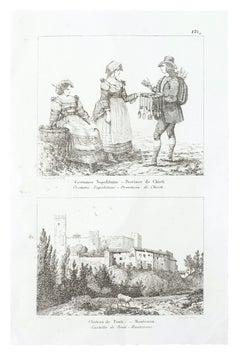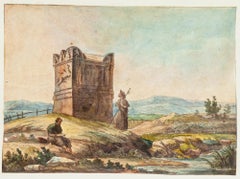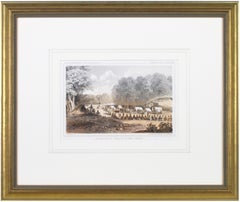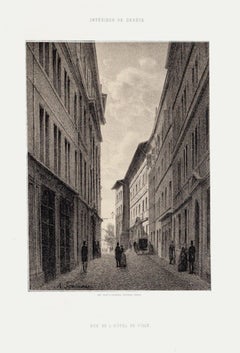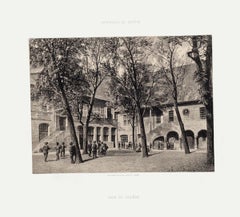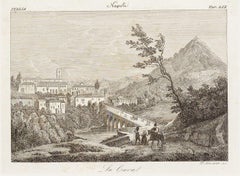19th Century Landscape Prints
to
74
1,458
466
103
38
17
Overall Width
to
Overall Height
to
897
76
67
12
7
6
3
2
1
114
54
34
33
27
1,016
2,097
9,952
4,108
117
119
689
516
588
1,112
1,476
1,735
1,302
599
657
1,472
603
5
1,252
451
373
285
243
194
180
173
137
134
131
128
118
99
96
94
93
89
80
76
1,073
654
287
252
98
185
1,276
911
627
Period: 19th Century
Scenes of Everyday Life in italy - Etching - 19th Century
Located in Roma, IT
Italian Landscape is an original print on paper, includes two images in one sheet, realized by an Anonymous. titled on the lower of each image.
In very good conditions.
Sheet dimen...
Category
19th Century Landscape Prints
Materials
Etching
Shepherds - Original Hand Watercolored Etching - 19th Century
Located in Roma, IT
Shepherds is an original etching, hand-colored on paper realized by an Anonymous artist of the XIX century, the state of artwork is excellent.
Image dimension: 12.5x17 cm.
Includi...
Category
19th Century Landscape Prints
Materials
Watercolor, Etching
'Distribution of Goods to the Gros Ventres' lithograph by John Mix Stanley
Located in Milwaukee, WI
In the mid-nineteenth century, the United States government set out to survey and document its newly acquired lands and territories west of the Mississippi. The goals of these surveys were manifold: to produce topographical maps, to document flora and fauna, and to document natural resources to build the emerging US economy. These surveys, and the images from them, also functioned to build the new sense of American identity with the landscape, condensing vistas into the 'picturesque' tradition of European image making. Thus, the entire span of US territory could be seen as a single, cohesive whole.
This lithograph comes from one of six surveys commissioned by the Army's Topographic Bureau in 1853, which sought to find the best route to construct a transcontinental railroad. The result was a thirteen-volume report including maps, lithographs, and technical data entitled 'Explorations and Surveys to ascertain the most practicable and economical route for a Railroad from the Mississippi river to the Pacific Ocean.' In particular, the print comes from the northern survey, commanded by Isaac Stevens, which explored the regions between the 47th and 49th parallels.
In this image, Stanley documented the encounter with the Gros Ventre people at Milk River. The explorers were invited to the Gros Ventres camp and the two groups exchanged gifts in friendship. The Stevens Party provided "... blankets, shirts, calico, knives, beads, paint, powder, shot, tobacco, hard bread, etc." The image likewise alludes to how, in 1855, Isaac Stevens, concluded a treaty (Stat., L., XI, 657) to provide peace between the United States and the Blackfoot, Flathead and Nez Perce tribes. The Gros Ventres signed the treaty as part of the Blackfoot Confederacy, whose territory near the Three Fork area became a common hunting ground for the Flathead, Nez Perce, Kootenai, and Crow Indians.
5.75 x 8.75 inches, image
6.5 x 9.25 inches, stone
17 x 20 inches, frame
Artist 'Stanley Del.' lower left
Entitled 'Distribution of Goods to the Gros Ventres' lower center margin
Publisher 'Sarony, Major & Knapp. Lith.s 449 Broadway N.Y.' lower right
Inscribed 'U.S.P.R.R. EXP. & SURVEYS — 47th & 49th PARALLELS' upper left
Inscribed 'GENERAL REPORT — PLATE XXI' upper right
Framed to conservation standards using 100 percent rag matting with French accents; glazed with UV5 Plexiglas to inhibit fading; housed in a gold reverse ogee moulding.
Print in overall good condition; some localized foxing and discoloration; minor surface abrasions to frame.
John Mix...
Category
Romantic 19th Century Landscape Prints
Materials
Lithograph
Geneva, Rue De L'Hôtel De Ville - Lithograph by A. Fontanesi - 1854
Located in Roma, IT
Image dimensions: 20.5 x 15 cm.
This splendid lithograph Interieur de Geneve. Rue De L'Hôtel De Ville is part of the series of 20 prints dedicated to views of the city of Geneva, en...
Category
Naturalistic 19th Century Landscape Prints
Materials
Lithograph
Geneva, Cour Du Collège - Lithograph by A. Fontanesi - 1854
Located in Roma, IT
This splendid lithograph Interieur de Geneve. Cour Du Collège is part of the series of 20 prints dedicated to views of the city of Geneva, engraved by the Italian artist Antonio Font...
Category
Naturalistic 19th Century Landscape Prints
Materials
Lithograph
La Cava (The Cave) - Etching by Francesco Mochetti - 1843
Located in Roma, IT
Image dimensions: 14.7 x 19.8 cm.
La Cava is an original black and white etching on paper, printed in 1843 as a plate of the print suite "90 Views of the citi...
Category
Modern 19th Century Landscape Prints
Materials
Etching
Design Fragment of St Albans Cathedral (1810), engraving by James Basire
Located in London, GB
James Basire & John Carter
Architectural Fragments of St Albans Cathedral
Engraving
62 x 46 cm
This engraving was originally published by the Society of Antiquaries of London, an...
Category
Realist 19th Century Landscape Prints
Materials
Engraving
Design fragments of St Albans Cathedral (1810), engraving by James Basire
Located in London, GB
James Basire & John Carter
Architectural Fragments of St Albans Cathedral
Engraving
62 x 46 cm
This engraving was originally published by the Society of Antiquaries of London, an...
Category
Realist 19th Century Landscape Prints
Materials
Engraving
Architectural Fragment of St Albans Cathedral (1810), engraving by James Basire
Located in London, GB
James Basire & John Carter
Architectural fragments of St Albans Cathedral
Engraving
62 x 46 cm
This engraving was originally published by the Society of Antiquaries of London, an...
Category
Realist 19th Century Landscape Prints
Materials
Engraving
Liber Veritatis - Original B/W Etching after Claude Lorrain - 1815
Located in Roma, IT
Image dimensions: 21 x 27 cm.
Liber Veritatis - Plate 145 is a beautiful black and white etching and aquatint on paper realized by the Italian artist Ludovico Caracciolo, after Clau...
Category
Old Masters 19th Century Landscape Prints
Materials
Etching, Aquatint
Liber Veritatis - B/W Etching after Claude Lorrain - 1815
Located in Roma, IT
Image dimensions: 21 x 27 cm.
Liber Veritatis - Plate 98 is a beautiful black and white etching and aquatint on paper realized by the Italian artist L...
Category
Old Masters 19th Century Landscape Prints
Materials
Etching, Aquatint
59: A Brig of Wars
Located in Columbia, MO
Edward William Cooke was born in Pentonville. His father, George Cooke, and uncle William Bernard Cooke were also well-known line engravers. Growing up in an environment of artists,...
Category
Naturalistic 19th Century Landscape Prints
Materials
Etching
46: Folkstone Harbour
Located in Columbia, MO
Edward William Cooke was born in Pentonville. His father, George Cooke, and uncle William Bernard Cooke were also well-known line engravers. Growing up in an environment of artists,...
Category
Naturalistic 19th Century Landscape Prints
Materials
Etching
41: Rope houses on the beach at Brighton
Located in Columbia, MO
Edward William Cooke was born in Pentonville. His father, George Cooke, and uncle William Bernard Cooke were also well-known line engravers. Growing up in an environment of artists,...
Category
Naturalistic 19th Century Landscape Prints
Materials
Etching
Liber Veritatis - B/W Etching after Claude Lorrain - 1815
Located in Roma, IT
Plate 23 – From Liber Veritatis
Aquatint on Copper, Imag. Dim: cm 33x47.5, Dim: cm 21x27,
Beautiful Artist’s Proof, representing a shepherd with his herd pastouring at the shore o...
Category
Old Masters 19th Century Landscape Prints
Materials
Etching, Aquatint
39: Thames Wherries
Located in Columbia, MO
Edward William Cooke was born in Pentonville. His father, George Cooke, and uncle William Bernard Cooke were also well-known line engravers. Growing up in an environment of artists,...
Category
Naturalistic 19th Century Landscape Prints
Materials
Etching
32: Sheer Hulk
Located in Columbia, MO
Edward William Cooke was born in Pentonville. His father, George Cooke, and uncle William Bernard Cooke were also well-known line engravers. Growing up in an environment of artists,...
Category
Naturalistic 19th Century Landscape Prints
Materials
Etching
14: Anchors
Located in Columbia, MO
Edward William Cooke was born in Pentonville. His father, George Cooke, and uncle William Bernard Cooke were also well-known line engravers. Growing up in an environment of artists,...
Category
Naturalistic 19th Century Landscape Prints
Materials
Etching
12: Lobster-boat at Rottingdean
Located in Columbia, MO
Edward William Cooke was born in Pentonville. His father, George Cooke, and uncle William Bernard Cooke were also well-known line engravers. Growing up in an environment of artists,...
Category
Naturalistic 19th Century Landscape Prints
Materials
Etching
Interieur de Geneve. Porte Neuve - Lithograph by A. Fontanesi
Located in Roma, IT
Image dimensions: 15 x 22 cm.
This splendid lithograph Interieur de Geneve. Porte Neuve is part of the series of 20 prints dedicated to views of the city of Geneva, engraved by the ...
Category
19th Century Landscape Prints
Materials
Lithograph
Au Bord d'une Rivière - Original Lithograph by A. Decamps
Located in Roma, IT
Au Bord d'une Rivière is an original artwork realized by Alexandre Decamps in 1831.
Original lithograph on paper.
Very good conditions.
Original artwork representing a river with ...
Category
19th Century Landscape Prints
Materials
Lithograph
04: A Frigate
Located in Columbia, MO
Edward William Cooke was born in Pentonville. His father, George Cooke, and uncle William Bernard Cooke were also well-known line engravers. Growing up in an environment of artists,...
Category
19th Century Landscape Prints
Materials
Etching
"San Salvador: Station d'Hiver des Arthritiques" Original Color Lithograph
Located in Milwaukee, WI
"San Salvador (Mediterranean)" is an original color lithograph poster by Ernest Louis Lessieux. It depicts a woman and her son on the picturesque coast of...
Category
19th Century Landscape Prints
Materials
Lithograph, Color
'Distribution of Goods to the Assiniboines' original John Mix Stanley lithograph
Located in Milwaukee, WI
In the mid-nineteenth century, the United States government set out to survey and document its newly acquired lands and territories west of the Mississippi. The goals of these surveys were manifold: to produce topographical maps, to document flora and fauna, and to document natural resources to build the emerging US economy. These surveys, and the images from them, also functioned to build the new sense of American identity with the landscape, condensing vistas into the 'picturesque' tradition of European image making. Thus, the entire span of US territory could be seen as a single, cohesive whole.
This lithograph comes from one of six surveys commissioned by the Army's Topographic Bureau in 1853, which sought to find the best route to construct a transcontinental railroad. The result was a thirteen-volume report including maps, lithographs, and technical data entitled 'Explorations and Surveys to ascertain the most practicable and economical route for a Railroad from the Mississippi river to the Pacific Ocean.'
When it came to depicting the Assiniboine people, as seen in the present print, Stanley chose to juxtapose their encampment, marked by tipis in the distance, with the encampment of the Isaac Stevens survey party. In the foreground, commemorating this moment, Isaac Stevens can be seen presenting trade goods, which are known to include thirty two dressed skins and two robes. The survey leader Isaac Stevens noted being grateful for the generosity of the Assiniboine, commenting: "I felt very grateful indeed to those Indians, for their kindness to my men, their proffer of kind feeling and hospitality to myself and the survey." This description and this image, however, are arguably depicted through rose-colored glasses: to the Assiniboine people, this meeting may well have included stressful diplomatic relationships and have indicated a threat to the sovereignty over the territories agreed to be theirs by the 1851 Treaty of Fort Laramie.
5.75 x 8.75 inches, image
6.5 x 9.25 inches, stone
17 x 19.75 inches, frame
Artist 'Stanley Del.' lower left
Entitled 'Distribution of Goods to the Assiniboines' lower center margin
Publisher 'Sarony, Major & Knapp. Lith.s 449 Broadway N.Y.' lower right
Inscribed 'U.S.P.R.R. EXP. & SURVEYS — 47th & 49th PARALLELS' upper left
Inscribed 'GENERAL REPORT — PLATE XIV' upper right
Framed to conservation standards using 100 percent rag matting with French accents; glazed with UV5 Plexiglas to inhibit fading; housed in a gold reverse ogee moulding.
Print in overall good condition; some localized foxing and discoloration; frame in excellent condition.
John Mix Stanley...
Category
Romantic 19th Century Landscape Prints
Materials
Lithograph
Novembre
Located in Roma, IT
Signed the plate with the artist's monogram “TS”lower left. Inscription “C. Lovera imp” lower right. Very rare print from “L'Art in Italia”, 1871.Original Prints.
Image Dimensions : ...
Category
Realist 19th Century Landscape Prints
Materials
Etching
Claude Lorrain Landscape with temptation of Saint Anthony, Aquatint by Earlom
Located in Greven, DE
Claude Lorrain landscape with the temptation of Saint Anthony .Richard Earlom aquatint c1817
by Lorrain, Claude le/Earlom, Richard
Country...
Category
Baroque 19th Century Landscape Prints
Materials
Paper
'Lieutenant Crovers Despatch – Return of Governor Stevens to Fort Benton'
Located in Milwaukee, WI
In the mid-nineteenth century, the United States government set out to survey and document its newly acquired lands and territories west of the Mississippi. The goals of these surveys were manifold: to produce topographical maps, to document flora and fauna, and to document natural resources to build the emerging US economy. These surveys, and the images from them, also functioned to build the new sense of American identity with the landscape, condensing vistas into the 'picturesque' tradition of European image making. Thus, the entire span of US territory could be seen as a single, cohesive whole.
This lithograph comes from one of six surveys commissioned by the Army's Topographic Bureau in 1853, which sought to find the best route to construct a transcontinental railroad. The result was a thirteen-volume report including maps, lithographs, and technical data entitled 'Explorations and Surveys to ascertain the most practicable and economical route for a Railroad from the Mississippi river to the Pacific Ocean.' In particular, the print comes from the northern survey, commanded by Isaac Stevens, which explored the regions between the 47th and 49th parallels.
5.75 x 8.75 inches, image
6.5 x 9.25 inches, stone
17 x 20 inches, frame
Artist 'Stanley Del.' lower left
Entitled 'Lieutenant Crovers Despatch – Return of Governor Stevens to Fort Benton' lower center margin
Publisher 'Sarony, Major & Knapp. Lith.s 449 Broadway N.Y.' lower right
Inscribed 'U.S.P.R.R. EXP. & SURVEYS — 47th & 49th PARALLELS' upper left
Inscribed 'GENERAL REPORT — PLATE XXXVII' upper right
Framed to conservation standards using 100 percent rag matting with French accents; glazed with UV5 Plexiglas to inhibit fading; housed in a gold reverse ogee moulding.
Print in overall good condition; some localized foxing and discoloration; minor surface abrasions to frame.
John Mix Stanley...
Category
Romantic 19th Century Landscape Prints
Materials
Lithograph
"Royalty Greeting Townspeople, " a Tempera Diptych from the Late 19th c.
Located in Milwaukee, WI
"Royalty Greeting Townspeople" is a Persian tempera diptych from the Late 19th century. It includes multiple figures in red and blue interacting in a f...
Category
Other Art Style 19th Century Landscape Prints
Materials
Tempera
Gabled Roofs
Located in New York, NY
James Abbot McNeill Whistler (1834-1903), Gabled Roofs, lithograph, 1893. Reference: Chicago (Spink et al) 64, only state. From the lifetime edition of 12 (there was also a posthumou...
Category
Impressionist 19th Century Landscape Prints
Materials
Lithograph
The Street, Chelsea Embankment
Located in New York, NY
Theodore Roussel (1847-1926), The Street, Chelsea Embankment, etching, 1888-9, signed in pencil on the tab and annotated “imp” [also signed lower left in the plate]. Reference: Hausb...
Category
Impressionist 19th Century Landscape Prints
Materials
Etching
Shere Mill Pond
Located in Missouri, MO
Shere Mill Pond, No. II (large plate). 1860. Etching and drypoint. Schneiderman 37.v/ix. 7 x 13 1/8 (sheet 10 3/4 x 16 3/8). This state is prior to publication in Études à l'Eau-Forte. Illustrated: Keppel The Golden Age of Engraving; Print Collector's Quarterly 1 (1911): 18; : Guichard, British Etchers, 1850-1940. A rich, brilliant proof with drypoint burr printed on white laid paper. Signed in pencil.
-------------------------------------------------------------------------------------------
Shere Mill Pond, No. II was one of the most highly praised landscape prints of the etching revival. An impression was exhibited at the Royal Academy in 1861 under Haden’s pseudonym, H. Dean. Francis Seymour Haden used this anagram of his own name early in his career as an artist, in order to retain his anonymity and preserve his professional reputation as a surgeon.
Biography:
Sir Francis Seymour Haden (16 September 1818 - 1 June 1910), was an English surgeon, best known as an etcher.
He was born in London, his father, Charles Thomas Haden, being a well-known doctor and lover of music. He was educated at Derby School, Christ's Hospital, and University College, London, and also studied at the Sorbonne, Paris, where he took his degree in 1840. He was admitted as a member of the College of Surgeons in London in 1842.
In 1843-1844, with his friends Duval, Le Cannes and Colonel Guibout, he travelled in Italy and made his first sketches from nature. Haden attended no art school and had no art teachers, but between 1845 and 1848 he studied portfolios of prints belonging to a second-hand dealer named Love, who had a shop in Bunhill Row, the old Quaker quarter of London. Arranging the prints in chronological order, he studied the works of the great original engravers, Albrecht Dürer, Lucas van Leyden and Rembrandt. These studies, besides influencing his original work, led to his important monograph on the etched work of Rembrandt. By lecture and book, and with the aid of the memorable exhibition at the Burlington Fine Arts Club in 1877, he tried to give a true reflection of Rembrandt's work, giving a nobler idea of the master's mind by taking away from the list of his works many dull and unseemly plates that had long been included in the lists. His reasons were founded upon the results of a study of the master's works in chronological order, and are clearly expressed in his monograph, The Etched Work of Rembrandt critically reconsidered, privately printed in 1877, and in The Etched Work of Rembrandt True and False (1895).
Haden's printmaking was invigorated by his much younger brother-in-law, James Whistler, at the Haden home in Sloane Street in 1855. A press was installed there and for a while Haden and Whistler collaborated on a series of etchings of the Thames. The relationship and project did not last.
Haden followed the art of original etching with such vigour that he became not only the foremost British exponent of that art but brought about its revival in England. His strenuous efforts and perseverance, aided by the secretarial ability of Sir WR Drake, resulted in the foundation of the Royal Society of Painter-Etchers and Engravers. As president he ruled the society with a strong hand from its first beginnings in 1880.
Notwithstanding his study of the old masters of his art, Haden's own plates were very individual, and are particularly noticeable for a fine original treatment of landscape subjects, free and open in line, clear and well divided in mass, and full of a noble and dignified style of his own. Even when working from a picture his personality dominates the plate, as for example in the large plate he etched after J.M.W. Turner's "Calais Pier," which is a classical example of what interpretative work can do in black and white. Of his original plates, more than 250 in number, one of the most notable was the large "Breaking up of the Agamemnon."
An early plate, rare and most beautiful, is "Thames Fisherman". "Mytton Hall" is broad in treatment, and a fine rendering of a shady avenue of yew trees leading to an old manor-house in sunlight. "Sub Tegmine" was etched in Greenwich Park in 1859; and "Early Morning--Richmond", full of the poetry and freshness of the hour, was done, according to Haden, actually at sunrise. One of the rarest and most beautiful of his plates is "A By-Road in Tipperary"; "Combe Bottom" is another; and "Shere Mill Pond" (both the small study and the larger plate), "Sunset in Ireland," "Penton Hook," "Grim Spain" and "Evening Fishing, Longparish," are also notable examples of his genius. A catalogue of his works was begun by Sir William Drake and completed by Harrington in 1880. During later years Haden began to practise the sister art...
Category
Old Masters 19th Century Landscape Prints
Materials
Drypoint, Etching
Original Japanese Watercolor and Woodblock Print of Orchid and Swallows
Located in Burbank, CA
Orchid and small swallows (Hokuri, kotsubame). Original preparatory watercolor next to the finished original Japanese woodblock print. This is a highly finished preparatory watercolo...
Category
Art Deco 19th Century Landscape Prints
Materials
Watercolor, Woodcut
$1,900 Sale Price
32% Off
Claude Lorraine Landscape, Richard Earlom Aquatint, 1810
Located in Greven, DE
Claude Lorrain landscape. Richard Earlom aquatint c1810
by Lorrain, Claude le/Earlom, Richard
Countryside with hunters and a deer , by Richard Earlom after Claude Lorrain.
Richard ...
Category
Baroque 19th Century Landscape Prints
Materials
Paper
Original Victorian card with flower arrangement and ice skating scene
Located in Milwaukee, WI
Business cards like this fall into the category of what art historians today generally refer to as "ephemera." Ones like this were produced for companies in the late 19th century, pr...
Category
Romantic 19th Century Landscape Prints
Materials
Lithograph
"Birthplace of Henry Clay, Hanover County, VA, " Lithograph by Kelloggs & Thayer
Located in Milwaukee, WI
"Birthplace of Henry Clay, Hanover County, Virginia" is an original hand-colored lithograph by Kelloggs & Thayer. The piece features a homestead and farm anima...
Category
Victorian 19th Century Landscape Prints
Materials
Lithograph
Original Japanese Watercolor and Woodblock Print of a Lark, Barley and Beans
Located in Burbank, CA
Barley, broad beans and a lark (Omugi, soramame, hibari). Original preparatory watercolor next to the finished original Japanese woodblock print. This is a highly finished preparator...
Category
Art Deco 19th Century Landscape Prints
Materials
Watercolor, Woodcut
$1,900 Sale Price
32% Off
Birds Eye View of Cheshire Connecticut 1882 lithograph pub. by O. H. Bailey
Located in Paonia, CO
View of Cheshire, Connecticut, 1882. Original lithograph was drawn and published by O. H. Bailey & Co. , a prominent 19th century map maker. The map shows a bird’s eye view of the town as it used to be, including street names and old landmarks. Beautifully colored historic map...
Category
Other Art Style 19th Century Landscape Prints
Materials
Lithograph
Umewaka Shrine in the Rain
By Kobayashi Kiyochika
Located in Burbank, CA
Umewaka Shrine, from an untitled series of prints depicting Tokyo. A woman braces her umbrella against the rain and a man waits out the storm next to his jinriksha in this view of th...
Category
Edo 19th Century Landscape Prints
Materials
Handmade Paper, Mulberry Paper, Woodcut
Terriers No. 1
Located in Columbia, MO
Terriers No. 1
1883-84
Chromolithograph
8.5 x 11 inches
Category
Naturalistic 19th Century Landscape Prints
Materials
Lithograph
Map of the County of Buckingham From an Actual Survey
Located in Paonia, CO
Cartographers Christopher (1786-1855) and John (1791-1867) Greenwood were surveyors from Yorkshire, who undertook an ambitious project to produce a series of large-scale maps of the counties of England, Wales and Scotland.The maps represent a remarkable and impressive surveying achievement forming an important record of the counties depicted.
In the years 1817-1832 the Greenwood brothers published the Atlas of The Counties of England from an Actual Survey. This Atlas was finely drafted and engraved and decorated with large vignettes of prominent buildings of the county. This map of Buckingham County is beautifully hand colored and is in very good condition. There is a vignette of Stowe House...
Category
Other Art Style 19th Century Landscape Prints
Materials
Engraving
Crystal Palace - View from The North Bank of the Serpentine
Located in London, GB
Rudolph Ackermann (1764-1831)
Crystal Palace - View from The North Bank of the Serpentine
Tinted Lithograph
31 x 46 cm
A nineteenth-century view of Crystal Palace from the north b...
Category
Realist 19th Century Landscape Prints
Materials
Lithograph
Facade of the Pronaos of the Temple of Edfou - David Roberts - orientalist
Located in London, GB
David Roberts
1796 - 1864
Facade of the Pronaos of the Temple of Edfou
First Edition lithograph
Full plate: 208
Presented in a acid free mount
We have all 250 of the Lithograph set...
Category
19th Century Landscape Prints
Materials
Lithograph
Lower Portion of El Khasne, Petra
Located in London, GB
Subscription and first edition lithograph in stock
Full plate: 94
Presented in a acid free mount
Category
Victorian 19th Century Landscape Prints
Materials
Lithograph
Black and white landscape etching dominated by mighty tower, by italian engraver
Located in Milan, IT
Il torrione
Ref. 397
Original etching, signed and numbered. Limited edition of 90.
Federica Galli was one of Italy's leading contemporary etchers.
She achieved this fame because she was able to interpret views, as Milan and Venice, landscapes and architecture with a poetic and original eye.
Moreover she had the foresight to portray the beauty of the great Italian trees...
Category
Realist 19th Century Landscape Prints
Materials
Etching
19th century landscape of rome daily life by fine print master Sir Muirhead Bone
Located in Milan, IT
Original etching and drypoint, signed in the plate and in pencil in the lower right corner; Dodgson "Etchings and drypoints by Muirhead Bone", Print Collector's Quarterly, 1922, IX, p. 173-200; Mackenzie, British Prints, p. 57; 400 x 278 mm
Superb test with signs particularly rich in beards, a characteristic typical only of the first tests: the pictorial effect is very effective. Small uneven margins. In perfect state of conservation.
Rich of burr drypoint, 1916, printed on cream paper. Good margins all around. In good condition.
Sir Muirhead Bone (23 March 1876 - 21 October 1953) was a Scottish etcher and watercolorist who became known for his depiction of industrial and architectural subjects and his work as a war artist in both the First and Second World Wars. Bone was an active member of both the British War Memorials Committee in the First World War and the War Artists...
Category
English School 19th Century Landscape Prints
Materials
Etching
Monastery of St. Augustine, Canterbury /// William Dugdale Monasticon Anglicanum
Located in Saint Augustine, FL
Artist: Sir William Dugdale (English, 1605-1686)
Title: "Monastery of St. Augustine, Canterbury"
Portfolio: Monasticon Anglicanum: A History of the Abbies and Other Monasteries, Hosp...
Category
Old Masters 19th Century Landscape Prints
Materials
Engraving
El Deir, Petra
Located in London, GB
Available in the First Edition lithograph
Full plate: 90
Presented in a acid free mount
We only sell the original 19th century lithographs by David Roberts, please read the informa...
Category
Victorian 19th Century Landscape Prints
Materials
Lithograph
Principal Court of the Convent of St. Catherine
Located in London, GB
First Edition lithograph
Full plate: 120
Presented in a acid free mount
Category
Victorian 19th Century Landscape Prints
Materials
Lithograph
Remains of the Triumphal Arch, Petra
Located in London, GB
David Roberts RA
Remains of the Triumphal Arch, Petra
1796 - 1864
Subscription and First Edition lithographs
Full plate: 100
Presented in a acid free mount
Category
Victorian 19th Century Landscape Prints
Materials
Lithograph
The Theatre, Petra
Located in London, GB
First Edition lithograph
Full plate: 98
Presented in a acid free mount
Category
Victorian 19th Century Landscape Prints
Materials
Lithograph
HEARN'S
Located in Portland, ME
Mielatz, Charles. HEARN'S. Etching, 1912. Edition size not known. Signed and dated in the plate. 12 X 7 1/2 inches. In excellent condition. Mielatz, taught etching at the National A...
Category
19th Century Landscape Prints
Materials
Etching
Kom Ombo - David Roberts - Orientalist
Located in London, GB
David Roberts
1796 - 1864
Kom Ombo
First Edition lithograph
Full plate: 210
Presented in an acid free mount
Category
19th Century Landscape Prints
Materials
Lithograph
Convent of St. Catherine, Mt. Horeb
Located in London, GB
First edition lithographs in stock
Full plate: 118
Presented in a acid free mount
Category
Victorian 19th Century Landscape Prints
Materials
Lithograph
Obersee by François Roffiaen (1820-1898) Oil on canvas
Located in Gent, VOV
The Watsman, a painted view between Obersee and Koningsee, Upper Bavaria. Study painted in 1856 by François Roffiaen.
François Roffiaen (1820-1898): Biography
François Roffiaen's f...
Category
19th Century Landscape Prints
Materials
Canvas, Oil
Claude Lorrain Landscape with Hermes and the Muses, Aquatint by Richard Earlom
Located in Greven, DE
Claude Lorrain landscape with the God Hermes, Amor and the Muses. Richard Earlom aquatint c1817
by Lorrain, Claude le/Earlom, Richard
Countryside with ...
Category
Baroque 19th Century Landscape Prints
Materials
Paper
The Gate, Chelsea
Located in New York, NY
Theodore Roussel (1847-1926), The Gate, Chelsea; etching and drypoint, 1889-1890, signed on the tab and inscribed imp [also signed in the plate lowere right]. Reference: Hausberg 33, fourth state (of 4), from the total printing of about 43 impressions. In excellent condition, trimmed by the artist all around on the plate mark except for the tab, 8 1/8 x 6 1/2 inches.
A fine impression, printed on a light cream wove paper with plate tone (wiped to brighten the gate and doorway area) and substantial burr in the drypoint work.
According to Hausberg, “The gate and house behind it still stand today at No. 4 Cheyne Walk...
Category
Impressionist 19th Century Landscape Prints
Materials
Drypoint, Etching
Boston
Located in Missouri, MO
John William Hill (1812-1879)
"Boston" 1857
Hand-Colored Engraving
Site Size: 29 x 41 inches
Framed Size: 39 x 52 inches
Born in London, England, John William Hill came to America with his family at age 7. His father, John Hill, was a well-known landscape painter, engraver, and aquatintist. John William had a career of two phases, a city topographer-engraver and then, the leading pre-Rafaelite school painter in this country. Employed by the New York Geological Survey and then by Smith Brothers...
Category
Pre-Raphaelite 19th Century Landscape Prints
Materials
Engraving, Aquatint
Price Upon Request
